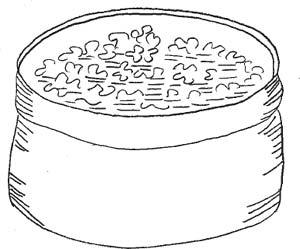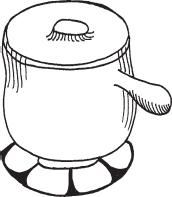Nourishing Traditions: The Cookbook That Challenges Politically Correct Nutrition and The... (139 page)
Authors: Sally Fallon,Pat Connolly,Phd. Mary G. Enig
Tags: #Non-Fiction, #Reference, #Science, #Health


SOUR CORN AND BEAN PORRIDGE
(Shuco)
Serves 6
1 cup black beans
½ cup lemon juice or whey
Whey and Cream Cheesefiltered water
2 teaspoons sea salt
3 cups freshly ground cornmeal
3 cups lime water (see A Word on Corn,
Whole Grains
)½ cup
pepitas
, finely ground in a mini millcayenne pepper
This interesting fermented dish from El Salvador is said to be good for a hangover! Purple or black cornmeal is normally used, but yellow cornmeal will do.
Cover beans with warm water, add ¼ cup whey or lemon juice and soak overnight. In the morning, drain and rinse the beans and place them in a pot with 1 teaspoon salt and water to cover them. Bring to a boil and skim off foam. Reduce heat, cover and simmer throughout the day.
In the evening, remove beans from the stove and leave them in their juice at room temperature overnight. Mix cornmeal with lime water and remaining ¼ cup whey or lemon juice and leave overnight at room temperature.
In the morning, add 2 cups water to the soaked cornmeal. Stir in salt, bring the batter to a boil and cook about 5 minutes, stirring constantly.
To serve, stir the beans into the corn mixture and simmer, stirring constantly, until they are warmed through. Ladle into bowls and sprinkle with ground pepitas and cayenne pepper to taste. Although not strictly traditional, the
shuco
may be garnished with cultured cream.
Fatty acids are essential parts of all body tissues where they are the major part of the phospholipid component of the cell membrane and are not just stored energy. Lowfat diets that supply adequate calories are basically high-carbohydrate diets. When the body does not get enough fat from the diet, it makes fats "from scratch" from carbohydrates. The fatty acids that the body synthesizes are saturated fatty acids—exactly the same kind of saturated fatty acids found in butter, cream and animal fat—and monounsaturated fatty acids—exactly the same kind of fatty acids found in olive oil. The cell membranes are composed of a combination of saturated, monounsaturated and polyunsaturated fatty acids.
It happens that the more fat you consume in your diet the less your body tissues need to make from scratch. But when you consume high levels of polyunsaturated fatty acids, such as the kind found in commercial vegetable oils, the normal body synthesis of saturated fat is depressed and the ingested polyunsaturated fats are used for structural fatty acids, leading to an unnatural balance in the membranes. . .. When the fat that is eaten is more highly unsaturated, the fatty acids available for incorporation into the tissue phospholipids are more unsaturated than the body normally prefers; and this causes a number of differences in membrane properties that are thought to be detrimental to the regular body economy. High levels of polyunsaturates in the diet have been shown to increase cholesterol levels in tissues, increase fat cell synthesis in growing animals, alter the response of the immune system, increase peroxidation products such as ceroid pigment, increase gallstone formation and, of all things, decrease HDL cholesterol in the blood. Mary G. Enig, PhD
PPNF Health Journal
BLACK BEAN AND CORN SALAD
Serves 6
2 cups basic black beans (
Basic Beans
), drained2 cups fresh corn kernels
2 jalapeno peppers, seeded and diced
1 red onion, finely chopped
1 cup
basic dressing
or 1 cup
lemon pepper dressing
Mix all ingredients together. Chill well before serving.

THREE BEAN SALAD
Serves 12
2 cups basic kidney beans (
Basic Beans
), drained2 cups
basic chickpeas
, drained2 pounds cooked
French beans
, cut into 1-inch lengths2 medium red onions, finely chopped
¼ cup finely chopped parsley
1 red pepper, cut into a julienne
1 green pepper, cut into a julienne
juice of 1 lemon
1 cup
garlic dressing
Mix all ingredients together. Let stand 1 hour or more before serving.
Animal proteins (meat, fish, milk products, eggs) seem to present many drawbacks. . .. Why not, then, replace animal protein with vegetable protein? These are found in grains, vegetables, oily fruits and, above all, pulses. But they are less well balanced than animal proteins. By proper combining of grains and pulses, one can improve the overall quality of protein from vegetable sources. But many people assimilate vegetable proteins less well than animal proteins. This leads to the common sense conclusion, found widely in books on diet and health, that half of our protein should be of animal origin and half of vegetable origin. This rule really has no scientific foundation, as it is only necessary to eat a small amount of animal protein to aid the assimilation of vegetable proteins. Tradition and science confirm each other in this for once. The tradition: the French
pot au feu
(beef bouillon with bread), Italian pasta with Parmesan cheese, Spanish
paella
, Moroccan
couscous
, Indian
thali
, Japanese fish with rice—always the animal products, whether meat, fish or dairy product, were traditionally eaten in very small quantities.
By economic necessity? Perhaps. . .. But also perhaps due to an ancestral intuition. For research done with animals has confirmed the wisdom of these practices. In one of these studies conducted in Latin America, rats were give mixtures of corn and beans in various proportions, the two foods that form the basis of the diet of a large part of the population. In whatever proportions these foods were given, the growth of the rats was insufficient, even if theoretically the amount of protein was adequate. In contrast, it was sufficient to add just 2% of fish to the bean-corn mixture to considerably raise the growth rate of the animals (from 70% to 120% greater, according to the proportions of the two main ingredients).
The small supplement of fish cannot in itself explain these spectacular results. Undoubtedly the added animal protein has a synergistic effect on the assimilation of the vegetable protein. The amount of fish given to the rats was the equivalent of 30 grams for a man—just one sardine!—as the only animal protein for the whole day. Another interesting observation: The combination of corn and fish (without beans) never gave as good results, whatever the amount of fish, as the trilogy of beans, corn and fish. Claude Aubert
Dis-Moi Comment Tu Cuisines

BASIC CHICKPEAS
Makes 3 cups
1 cup dried chickpeas
warm filtered water
2 tablespoons whey
Whey and Cream Cheese
or lemon juice1 teaspoon sea salt
Cover chickpeas with warm water. Stir in whey or lemon juice and leave in a warm spot for 24 hours. Drain, rinse and pick off skins. Transfer to a pot, add salt and water to cover and bring to a boil. Skim. Cover and simmer for about 6 hours or until chickpeas are very tender. Drain and use in salads.
CHICKPEA STEW
Serves 8
4 cups basic chickpeas (see above)
1 cup millet
2 cups warm filtered water mixed with 2 tablespoons whey
Whey and Cream Cheese
, lemon juice or vinegar2 medium onions, finely chopped
2 tablespoons butter
2 tablespoons extra virgin olive oil
8 cups
beef stock
or
chicken stock¼ teaspoon cayenne pepper
½ cup currants
1 head broccoli, cut into flowerets
1½ cups
Crispy Cashews
, chopped3-5 tablespoons lemon juice
sea salt and pepper
Soak millet in warm water plus whey, lemon juice or vinegar for at least 7 hours. Drain in a colander. Saute onions in butter and olive oil until soft. Add stock, bring to a boil and skim. Add millet, stirring with a whisk to prevent clumping. Add chickpeas, cayenne and currants, cover and simmer about 30 minutes. Add remaining ingredients and simmer a few minutes more or until broccoli is tender. Season to taste.
Chickpeas or garbanzo beans have been used for so long that they are unknown in their wild state. They form a staple of the diet in the Middle East and in Mediterranean countries. They are one of the most nutritious of all the legumes, high in calcium, phosphorus and potassium. They have an exceptionally high iron and vitamin C content and contain B complex as well. Like all pulses, they are rich in essential fatty acids. However, as chickpeas are high in omega-6 fatty acids compared to omega-3 fatty acids they should not be consumed to excess. Their bland taste marries well with onions, spices and sour foods. SWF
